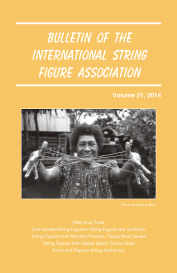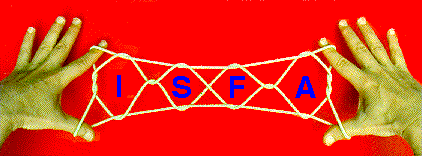volume 21 (2014) - Table des Matières
Edité par - Mark A. Sherman, Pasadena, California
Rédacteurs Associés - Joseph D'Antoni, Queens, New York; Myriam Namolaru, Haifa, Israel;
Belinda Holbrook, Davenport, Iowa; Stephan Claassen, Best, Netherlands.
Comité de Rédaction - Hiroshi Noguchi, Tokyo, Japan; Philip Noble, Inverness, Ecosse
Le Bulletin de l'Association Internationale du Jeu de Ficelle (BISFA) est une publication savante
présentant des documents originaux qui fait progresser notre compréhension et renforce
notre plaisir des jeux de ficelle. BISFA est publié annuellement, en septembre, par ISFA Press
(Pasadena, Californie). BISFA remplace le Bulletin de l'Association des Jeux de Ficelle,
(Toky Nippon Ayatori Kyokai), qui a été publiée en 19 volumes (1978-1993).
Les traductions proposées ne comprennent pas les illustrations et photos du texte original.
J'ai traduit ces textes pour vous donner un aperçu de la qualité et de la richesse de
ces publications.
Table of Contents - Volume 21 (2014): 284 pages

Research Reports
- The Multi-loop Twist: Twisting all loops simultaneously by Martin Probert, Devonshire, UK (pages 1-3) - In this article the author describes a movement specifically developed to remove the tediousness of the instruction ‘Twist all loops’ which occurs in many figures from Nauru and Tikopia.
- Jeux de ficelle faits d'une seule main par Martin Probert, Devonshire, UK (pages 4-11) - Les figures suivantes sont conçues pour quiconque, temporairement ou de manière permanente, ne peut employer qu'une seule main. Le stimulus pour créer de telles figures a eu lieu pendant Janvier 2014, le mois le plus humide et orageux dans le Royaume-Uni, depuis "l'indépendance Americaine" .Je me suis levé au milieu de la nuit pour fermer une fenêtre: le vent, saisissant la fenêtre et tournant mon poignet, a mis ma main au repos pour une semaine. J'ai rencontré, à diverses moments, un excellent jongleur manchot, et un tout aussi excellent magicien qui n'avait qu'une seule main. Peut-être que ces jeux de ficelle suggèreront un interessant et stimulant passe-temps pour quelqu'un de handicapé de manière similaire
- String Figures are not Knots by Martin Probert, Devonshire, UK (pages 12-14) - A discussion of the circumstances under which string figures may be considered as equivalent, and of the circumstances in which they are not equivalent.
- The Wampar String Figure Repertoire in Comparative Perspective: Social change and interethnic relations in Papua New Guinea by Bettina Beer, Lucerne, Switzerland, and Stephan Claassen, Best, Netherlands (pages 15-141) - The authors describe the structure, formation and interpretation of 35 different string figures (fafoa) made among the Wampar (Morobe province, Papua New Guinea). The string figures were recorded in 2003/4 and 2013, from families of the village of Gabsongkeg. Aspects of the context in which the string figures occur are described. Placed in a comparative perspective, the Wampar string figure repertoire reflects the various relations that existed and exist with neighboring and more distant ethnic groups in Papua New Guinea. Two of the string figures have (until now) only been recorded among the Wampar, while three have been recorded only among the Wampar and their neighbors, the Watut. Nowadays rapid social change often occurs in the communities of Papua New Guinea, and this is certainly true of the Wampar. The making of string figures now competes with several alternative pastimes. This has led to changes in the string figure tradition, yet the material presented in this paper does not support the conclusion that the repertoire is diminishing or that the tradition will die out soon.
- Wame: String Figure Chants and Stories from Saibai Island, Torres Strait: Wolfgang Laade’s 1966 film revisited by Stephan Claassen, Best, Netherlands (pages 142-243) - String figures from the 1965/66 film Wame: Traditional String Figures from Saibai Island, Torres Strait were transcribed by Honor Maude and published in 1987. Wolfgang Laade made transcripts and translations of the chants and stories (in the Kalaw Kawaw Ya language) accompanying the figures, but they were never published. The first part of the present paper presents these chants and stories together with the construction method, display and action of the string figures. Comparative notes accompany each figure. In addition, the construction methods of two additional figures and some construction parts, not published in 1987, are given. The film also contains a section in which several Kalaw Kawaw Ya technical terms used in string figure construction are demonstrated. The second part of the present paper presents and studies these technical terms. (une figure)
- Arctic Astronomy: Following the String by Alexey Andreev, Moscow, Russia (pages 244-250) - In the Arctic region only one string figure has been recorded that has a name clearly connected to celestial bodies. The author attempts to find an explanation for this, and he identifies additional Arctic string figures that might be related to astronomy.
- Papuan String Astronomy: All in One by Alexey Andreev, Moscow, Russia (pages 251-254) - The author compares names and figures of a string figure series occurring in Papua New Guinea and finds a strong connection to celestial bodies.
Book Reviews - by Joseph D'Antoni (pages 255-256)
- String Figures as Mathematics?: An Anthropological Approach to String Figure-making in Oral Tradition Societies by Eric Vandendriessche.
Letters to the Editor (pages 257-263)
- An Alternative Display of Double-Walled Diamonds - Joseph D'Antoni. Double-walled diamond string figures are typically displayed between upper and lower transverse frame lines running between hands. The author describes an alternative display that involves rotating the figure a quarter turn in its own plane.
- A Few Hints Regarding the Contents of Arthur Deacon's 'Lost' String Figure Collection - Philip D. Noble. A.B. Deacon's collection of New Hebrides string figures, mentioned in his posthumous 1934 book edited by Camilla Wedgwood, have never been found. The author provides a partial list of string figure names which he recently found among Deacon's field notes at the Royal Anthropological Institute in London, and provides instructions for performing one New Hebrides string trick.
- Marquesan String Figures 200 Years Ago - Walter Teamotuaitau. American Navy Captain David Porter visited Nukuhiva in the Marquesas Islands in the years 1813-1814, where he saws young girls making intricate string figures. His description of the event was published in 1815, but was not known to ISFA members until 2014. The author quotes the full passage.
Nomenclature - by Mark Sherman (pages 264-279)
- Abbreviations and terms used throughout the Bulletin are summarized and illustrated. Step-by-step illustrations for making five string figures (Look!, Drum, Two Fawns, Face Mask, and Two Arrowheads) are provided as examples.
Ajouter un commentaire


